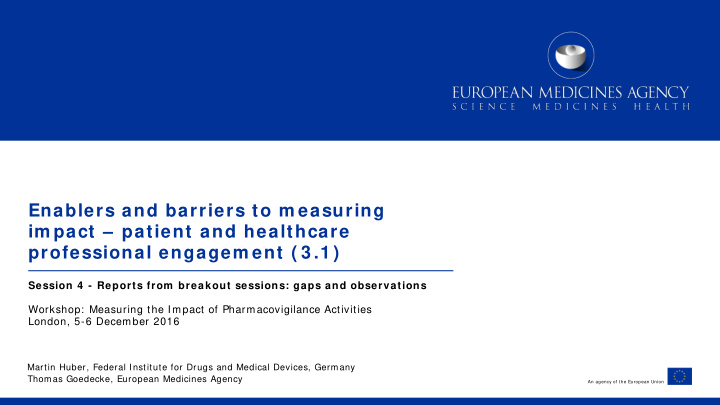



Enablers and barriers to m easuring im pact – patient and healthcare professional engagem ent ( 3 .1 ) Session 4 - Reports from breakout sessions: gaps and observations Workshop: Measuring the Impact of Pharmacovigilance Activities London, 5-6 December 2016 Martin Huber, Federal Institute for Drugs and Medical Devices, Germany Thomas Goedecke, European Medicines Agency An agency of the European Union
Session 3 .1 Topics 1 . Defining engagem ent – aw areness and perception of public health m easures Patrick Brown, University of Amsterdam 2 . I SPE paper “Evaluating the Effectiveness of Additional Risk Minim isation Measures via Surveys in Europe: Challenges and Recom m endations” Rachel Sobel, Pfizer Inc. and Terri Madison, Mapi Group 3 . Patient reporting in EudraVigilance – a m easure of patient engagem ent? Marin Banovac, European Medicines Agency 1
1 . Discussion points • Need to be sensitive to various actors in stakeholder engagement; • Trust is essential – Trust in industry initiatives is a barrier – needs to be improved; – If this is not possible the routes of communication needs to be adjusted; – Differentiate ‘blind’ trust versus ‘critical’ trust; • Regulators are a trusted source for information but success depends on health literacy (target the right groups and ensure they understand the message; • Also avoid negative messaging (pill scare) and focus also on positive aspects such as benefits of the product (which helps to build critical knowledge and trust); Focus on continuous HCP and patient education (as long term strategy to share best • practice, “education with the goal to cultural change”) 2
Exam ples • Focus on very simple methods for raising attention (e.g. one single DHPC per action in each MS); • Focus on universal tools for reporting ADRs; • Need to focus on the research question, i.e. what are the objectives of the regulatory action and how can these be measured? – But requires common understanding of underlying concepts (GVP vs CIOMS); • NCAs should take ownership and implement uniform measures, consider the right communication channels to reach HCP and patients; • Complex regulatory context leads to difficulties in carrying out research (e.g. conducting surveys for generics where product identification is an issue); • Address methodological issues with surveys (low response rates; low scientific reputation; challenges with regulatory classification of survey); 3
2 . Key findings • Insights from quantitative research methods may be enhanced through triangulation (i.e. survey data combined with data on behavioural outcomes and qualitative data); • Engagement (HCPs and patients) should go beyond reporting but also focus on participation in studies; • Careful evaluation whether each PhV activity needs an impact measure? – Consider before the measures are implemented and define measures of success (if possible); – Early planning of impact evaluation before taking regulatory actions (e.g. unintended consequences, what is the expected impact?); • Collaborative approach to inform HCP and patients about safety measures (e.g. additional risk minimisation measures) to overcome regulatory limitations? 4
3 . Challenges and gaps • Surveys: – due to low response rates put operational challenges in context of the disease; – is a survey the right measure or do qualitative techniques like focus groups provide more meaningful information? • Gap in understanding of patient perceptions and how patients value risk; • Not solely focus on patients but also HCP engagement and consider multiple relations; • Engage with the lay press to be more positive on pharmacovigilance and health-related communications; 5
4 . Recom m endations • Long term goal would be that people should take more responsibility for their health, but that requires a change in attitude and competences to be supported by education; • Closer collaboration with patient communities to establish their needs (2-way dialogue and include patients in all steps); • Recognising the heterogeneity of risk communication; • Standardised format for patient reporting (e.g. global format, easy to read and to enter the information) • Communication should focus on proper use of medicines across countries; • For specific suggestions and proposals on surveys see ISPE white paper; • Capacity building and understanding where patients can provide input (e.g. regulatory processes, risk communication etc.) 6
5 . Conclusions The overall question of this session is how engagement can be an enabler (or barrier?)? To answer this we need to understand and establish – Aw areness of pharm acovigilance – Trust of patients and HCPs in the regulatory system – Confidence that their contribution to im pact assessm ent w ill m ake a difference – Feasible m ethods to measure engagement as a prerequisite for impact research (cost, time, skills, data protection, technical means, social media etc.) 7
Recommend
More recommend